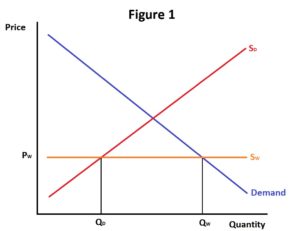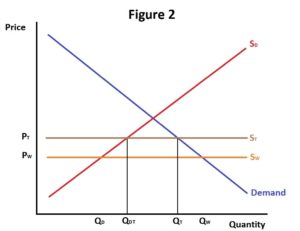Lumber prices in the United States hit a record high this past spring. In recent years, lumber futures have typically traded at $350–$400 per thousand board-feet, but they hit $1,670 in early May. Since then, they have fallen dramatically, but remain at elevated levels.
The high prices are unpleasant for the do-it-yourselfer shopping for poplar for new cabinets (just for example). They’re miserable for new homebuyers and for homeowners doing renovations. The headline-grabbing jump in U.S. home prices over the past 12 months underscores the importance of increasing the housing supply to meet burgeoning consumer demand, and high prices for a major input work against that. (For more on the current housing market, see this Econlog post.)
The primary cause of the high lumber prices is a dramatic shift in both supply and demand following the onset of the COVID pandemic. Tree harvesters and lumber mills, which cut production in the wake of the 2000s building bust, cut back further in the spring of 2020 to contend with COVID and fears of another bear market for their products. Meanwhile, beginning last summer, homebound DIYers and, later, contractors bid up the lumber that was available.
Another factor contributing to high U.S. lumber prices is the U.S. tariff on Canadian softwood lumber (that is, lumber from coniferous trees; think pine and fir, used for framing lumber and some types of plywood, as well as paper pulp). Current duties total about 9%, and they are set to rise to more than 18%, further crimping the supply of lumber and the provision of new housing.
It’s tempting to blame both ex-president Donald Trump (whose administration imposed a 20% duty 2017, before lowering it last year) and President Joe Biden for those tariffs, but they are set and adjusted by statute, as my Cato colleague Scott Lincicome explains here. Washington has been meddling off-and-on with the import of Canadian softwood since 1982.
To understand the economic harm of tariffs, consider some “textbook economics.” Figure 1 is the standard depiction of exchange in a market that has both domestic and foreign supplies of a good. Domestic demand has a downward (negative) slope reflecting the Law of Demand (the lower the price, the greater quantity will be consumed). Domestic supply SD has a positive slope reflecting the Law of Supply (the higher the price, the greater quantity will be supplied). World supply SW is depicted with zero slope under the assumption that this market is too small to affect the equilibrium world price PW, and hence world supply is de facto perfectly elastic in this market. The total quantity of the good consumed in this market at price PW is QW, of which QD is supplied by domestic producers and the rest is provided by imports. As a result, domestic consumers receive greater benefit — that is, more consumer surplus — from the competition from foreign supply.

Figure 2 is the textbook case of what happens when a tariff is applied to foreign supply. Total supply is now represented by ST, which is above SW, reflecting the tariff’s effect on price. ST’s intersection with domestic demand establishes the domestic price PT, which is higher than PW, and the quantity consumed at that price, QT, which is less than QW.

Put simply, the tariff results in less of the good being consumed by the domestic market, and consumers pay a higher price for it. Domestic producers do benefit from the tariff because they can profitably sell more of their product in the domestic market (and receive more producer surplus), as indicated by QDT. Government likewise benefits because it receives tax revenue equal to the area of the rectangle framed by ST, SW, QDT and QT. So, for domestic producers and government, the tariff is great — but not for domestic consumers, who lose a chunk of their consumer surplus—partly to the transfer of tariff revenue to the government, and partly to deadweight loss (the two triangles to the left and right of the government tax rectangle).
As bad as the textbook case is, the real-world case of the softwood lumber tariff is worse. As previously noted, the tariff is a percentage of the base price, so in this market ST would have a positive slope even if SW is perfectly elastic. As a result, the tariff grows larger, and its negative effect on consumers worsens, when prices are elevated.
Softwood lumber is not the only housing input affected by both COVID conditions and U.S. tariffs. Scott has put together this exhaustive — and infuriating — list. Unlike softwood lumber, some of these duties were implemented under Trump’s discretion and are being continued under Biden’s.
American households have suffered through a lot over the past 18 months. The U.S. government should give them a break by dispensing with harmful tariffs. The duties on housing inputs would be a great place to start.


READER COMMENTS
Richard A.
Jul 16 2021 at 3:48pm
There has been a dramatic price decline in the world price for solar cells and panels. Unfortunately, Obama hit china with tariffs on solar, then Trump hit the world with a tariff on solar which is now at 18%, now Biden refuses to remove Trump’s tariff. Worse, Biden is increasing the restrictions of solar products from the China’s Xinjiang region. This is causing the cost of solar energy in the US to be well above the world price with the result that solar installations are happening at a slower pace.
As near as I can tell, Japan and the EU are allowing their consumers to buy solar panels close to the world price.
The Impact of Tariffs on Utility-Scale Solar
Pierre Lemieux
Jul 17 2021 at 10:59am
Your point, as well as Thomas’s, illustrates how, in many ways, Biden is Trump 2.0. For more on this, see my forecast of early this year in the Spring issue of Regulation.
David Seltzer
Jul 19 2021 at 12:09pm
Thomas: I’m studying econ via online courses, various videos and other internet outlets. Your examples make these concepts much clearer. Especially elasticity of supply, consumer surplus, producer surplus and dead weight loss imposed by taxes and tariffs.
Thomas Firey
Jul 20 2021 at 10:09pm
Thanks David. Good luck with the coursework. Keep chopping wood!
Comments are closed.